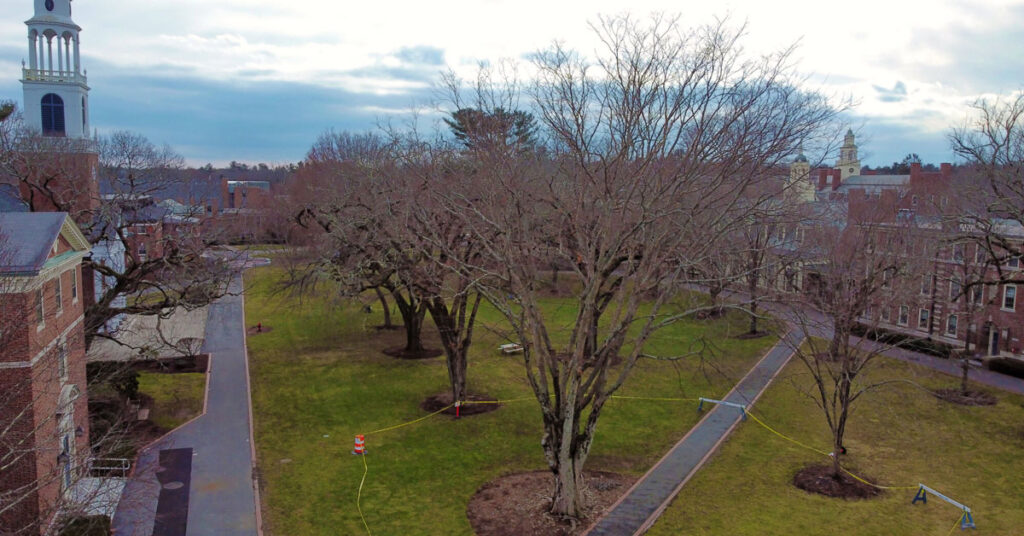Arborist report leads to tree removal

Dimple loses 95-foot-tall tree to disease; new one to be planted in spring
At Wheaton, trees are special. They help shape the beauty of the campus landscape, connect graduates to the college through the plantings that mark class years, and provide a source of intellectual engagement for students as well as visitors interested in learning about different species.
When they need to be removed for various reasons, including weather-related damage and disease, the loss is noticed as well as lamented by the campus community. Such is the case for the Japanese Zelkova (Zelkova serrata) that for decades has dramatically stood at the entrance of the Dimple near Knapton Hall.
For at least 10 years, the grounds crew has tended to the tree, trying to shore it up, especially when it was in danger of splitting apart. However, it has been slowly losing bark and branches.
In recent weeks, yellow tape and a saw horse had surrounded the 95-foot-tall dying tree for safety. On Wednesday, January 12, it was cut down to protect passersby as well as buildings after a risk assessment by a consulting arborist confirmed multiple issues with the tree, including decay, fungal cankers and nectria canker, said John Sullivan, assistant vice president of business services and physical plant.
According to the arborist, “there were several cracks and splits on the main trunk of the tree. The vertical crack facing Knapton Hall measured 31 inches deep and a vertical crack facing Larcom Hall was eight inches deep. … Horizontal cracks are rare and may indicate wood fiber collapsing in compression. At this point, failure of the stem is more likely.”
Sullivan said he plans to work with Professor of Biology Scott Shumway and others to replace the tree with a new planting this spring. Also, “Professor Kelly Goff will be connecting with our tree removal contractor to see if he can obtain a viable section to use in art work. If this works out, then the life of the tree continues, even beyond its removal,” Sullivan said.
“I’m not sure if I’ll use it for my personal work or if it will be available for student artists in the future,” Goff, associate professor of visual art, said on Tuesday before the tree cutting. “I’m a tree lover and I have a wooden heart. My plan is to evaluate the tree as it comes down [with help from a friend who operates a small sawmill locally] to make sure that we are able to put any usable material to good use.”
Wheaton has been very intentional in its stewarding of trees, Sullivan noted. The college’s care program includes bringing a company to campus annually to treat the elms for disease prevention, spraying for gypsy moths when needed, working with contractors to selectively prune trees and consulting with an arborist.
Like many others on campus, the Dimple tree has historical significance because it was adopted by graduates of 1950 as their class tree after their original tree, an elm, died, according to Kate Boylan, Wheaton director of archives and digital initiatives.
The College History page indicates that in 1900, the first senior class chose an already standing elm tree and conducted Commencement around it. The tradition evolved into each senior class choosing a day during the second week of April to plant a new tree on campus.
When former College Archivist Zephorene Stickney Helmreich arrived on campus in 1980, she began keeping track of trees on campus to piece together historical records on trees, ivys, benches and markers, said Boylan.
Over the years, Wheaton has amassed an extensive collection of native and non-native species of trees and shrubs, which are highlighted in the annual tree walk started by the late Professor of Philosophy Holcombe Austin that has been continued by Professor Shumway.
Shumway, who teaches botany, among other subjects, is well-known for his tree walk events during Reunion. He even created a tree scavenger hunt that requires participants to answer trivia questions. The professor used to begin his botany classes by sending students out to find the answers.
Ask him why this particular Zelkova serrata tree is special and Shumway’s passion comes through.
“All trees are special. This one more so because of its large size, shape and how it captures the eye of anyone who has ever visited campus,” he said. “Words are not needed to express the ways in which this tree is special—just look at it.”
“We forget the basics of what makes trees special. Aesthetics is just one thing. They are our best defense against global warming. They take up carbon dioxide as they photosynthesize and convert the carbon into the building blocks of the plant,” Shumway said. “The wood in this tree is storing about 100 years worth of accumulated carbon that was removed from the atmosphere by the leaves of the tree. Once it dies and begins to decay, that stored CO2 gets released back into the atmosphere. Big trees store more carbon.”
